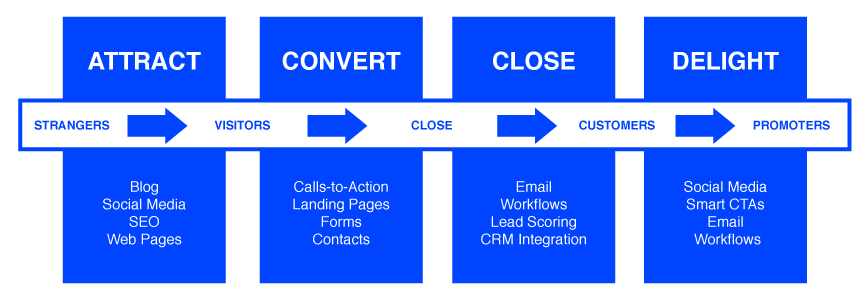Consumers’ buying habits are changing. Shoppers are researching services and products more thoroughly before making purchases and relying increasingly more on reviews on social media and review sites like Yelp. In fact, online buyers are through 57% of the buyer’s journey before even talking to a sales representative. And 80% favor getting brand information from reading articles over ads.
The traditional flashy pop-up ads and cold calling marketing tactics are fading out, and businesses are in need of finding more strategic ways to get their audience’s attention.
Enter: inbound marketing
The inbound marketing methodology is defined by HubSpot as, “the best way to turn strangers into customers and promoters of your business.”

Inbound Marketing Methodology
With the above method, inbound marketing aims to drive warm leads in towards your business by using digital marketing tools such as search engine optimization (SEO), blogging, content marketing, social media, paid digital advertising, videos, and more. In other words, inbound marketing is any form of marketing that is built on earning people’s interest, not buying it. Unlike traditional marketing, inbound marketers aspire to provide value, educate (or entertain) their customers, and create content that attract customers to you.
If you’re still unsure if your business needs to utilize inbound marketing, here are five more reasons many businesses are switching up their marketing efforts.
You can track results for anything, anytime
Inbound marketing usually includes SEO, PPC campaigns, marketing automation, social media, email marketing, and other lead generation strategies. If you use the right software when setting up all your various campaigns, you’ll be able to easily track the results.
This data will help you see what social media posts get the best engagement, what keywords attract the most leads, or which blog post receives the most shares or garners the highest amount of CTA (call-to-action) clicks. In addition, you can A/B test landing pages to learn what designs and content have a better conversion rate, or which pages on your website visitors view and interact with the most.
You can continually improve your marketing strategy
With outbound, you know your marketing isn’t working when you’re not making money — but you don’t always know why your marketing isn’t yielding the results you want. Tools like HubSpot and Google Analytics give you the ability to track all your marketing efforts, so you’ll be able to see what works and fix what doesn’t.
By continually editing your campaigns — especially when doing so based on solid data — you’ll not only generate leads, but revenue as well.
You attract more leads
As you improve your marketing and figure out what works best for your business, you’ll produce more, higher quality leads. More specifically, you’ll produce visitors and leads that come to you.
According to a study by Gartner, “properly executed Inbound Marketing tactics are ten times more effective for lead conversion compared to outbound methods.”
Not to mention that businesses that publish around 15 blogs per month convert 1,200 new leads monthly. And, of course, the more leads you receive, the more opportunity for closing them, and the higher chance of success your business will have.
It’s affordable
While campaigns like PPC still have a cost, inbound marketing, overall, is more affordable than traditional methods. According to HubSpot, inbound marketing costs 62% less per lead than outbound marketing, and three out of four inbound channels (like blogs and social media) cost less than any outbound channels (like direct mail and trade shows).
As previously mentioned, inbound marketing doesn’t just generate leads, it generates revenue. For instance, companies that automate their lead nurturing cycle see a 10% increase in ROI over a six to nine month period.
The decline of outbound
From smartphones to smartwatches, people are more in control of the information they receive — and how they receive it — than ever before. With the increasing use of spam filters, ad blockers, and “Do Not Call” lists, interruptive cold calls and pop-up ads are no longer as effective as they once were.
Inbound marketing creates an opportunity for businesses to communicate and interact with their audience in new, more strategic ways. Rather than interruptive tactics, inbound marketers use content creation, multi-channel communication, and other less intrusive methods to provide value, educate and entertain, and create content that draws customers to you.